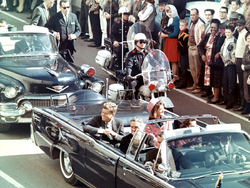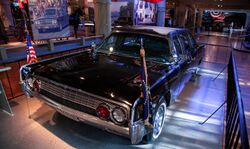Engineering:SS-100-X
SS-100-X was the U.S. Secret Service code name for the presidential limousine originally used by the 35th President of the United States, John F. Kennedy. The limousine is the car in which Kennedy and First Lady Jacqueline Kennedy were passengers when the President was assassinated in Dallas, Texas on November 22, 1963.
Following Kennedy's assassination, the car received significant armor plating and a bullet-proof hardtop and its navy blue exterior was painted black. It resumed its role as a presidential limousine for President Lyndon B. Johnson until 1967 and later remained in service until 1978, when it was sent to the Henry Ford Museum in Dearborn, Michigan.[1]
SS-100-X was originally a standard 1961 Lincoln Continental four door convertible (model 74A) built by the Ford Motor Company and assembled at the Wixom, Michigan plant. It had a retail price of $7,347 (equivalent to $62,859, as of 2019[2]).
The car was moved to the Experimental Garage at the Ford Proving Grounds where an additional 41 inches was added between the front and rear doors and just beyond the rear doors.[citation needed] The car's frame was strengthened to accommodate the additional length and weight. It was painted a special navy blue color and taken to Hess & Eisenhardt of Cincinnati, Ohio, for reupholstering and further modifications to Secret Service specifications.[clarification needed] During the refit the car had no bulletproof or bullet-resistant additions added. The windshield remained the standard two-ply safety glass which could be easily replaced at any dealership.
It was first delivered to the White House on June 15, 1961 and measured 255 inches (6.5 m) long, had a wheelbase of 156 inches (4.0 m), was 78.6 inches (2.00 m) wide, and 57 inches (1.4 m) high. It weighed 7,800 pounds (3,500 kg), up 1,585 pounds (719 kg) from factory weight, and was powered by a hand-built 350-horsepower 430-cubic-inch (7,000 cm3) Ford MEL engine.
An open car, the Lincoln was equipped with an assortment of tops, including a snap-together bubble top, a black cover for the bubble, a formal rear top and a stainless steel forward section (none of which were bulletproof). It also featured two-way radio telephones[1] and retractable steps and grab-handles for Secret Service agents. No armor plate was added to the bodywork, but the undercarriage and all suspension components were strengthened. A hydraulically-lifted rear seat was fitted. At the time of the assassination, the Lincoln had been fitted with a 1962-model front clip (fenders, hood, grille and bumper assemblies).
It had a special short-turn radius, 61.9 feet (18.9 m), compared to 64 feet (20 m) on the 1950 Eisenhower "bubbletop" which had been its predecessor. Total cost of modifications was approximately $200,000 (equivalent to $1.34 million in 2019[3]). The limousine was registered to the Ford Motor Company and was leased to the Secret Service for a nominal fee of $500 per year (equivalent to $4,278 in 2019[2]).[4]
The limousine carried the District of Columbia license plate GG 300. In November 2015, the license plates were sold at auction for $100,000.[5]
Kennedy assassination
On November 21, 1963 SS-100-X was loaded onto a Fairchild C-123 Provider piloted by Captain Thomason of the 76th Air Transport Squadron and flown to Brooks Air Force Base in San Antonio, Texas and then onto Dallas Love Field in Dallas, Texas where it was stored in an underground car park.
Following the shooting of President Kennedy and Governor Connally at approximately 12:30 pm, SS-100-X was driven to Parkland Memorial Hospital, where Kennedy died at 1:00 pm, 30 minutes after he was shot at Dealey Plaza. The Plexiglas bubble top and cloth cover were then attached. Later that afternoon at 3:30 pm CST, the limousine was taken to Love Field and loaded on a Lockheed C-130 Hercules and flown to Andrews Air Force Base , Washington D.C., landing at 8 pm EST. After arrival at Andrews AFB, the limo was delivered to the White House garage.
Post-assassination
In late December 1963, the car was sent back to Hess & Eisenhardt to be modified further, and was rebuilt from the ground up. For protection, the Lincoln received titanium armor plating, bullet-resistant glass and a bulletproof permanent roof. Solid aluminium rims were also fitted inside the tires to make them flat-proof. It remained in service for an additional eight years, logging 50,000 miles on the ground and over one million miles being flown to and from its destinations. The vehicle was equipped with Presidential lap robes and mouton carpeting and a complete communications system including radio patch to the White House. It was replaced in 1967 and remained in service doing less important duties until 1978, when it was retired to the Henry Ford Museum. Finished originally in navy blue, the car was repainted black after the assassination, then repainted again[clarification needed] after each assignment.[6]
Former Secret Service agent Clint Hill, who leapt onto the limousine directly after Kennedy was shot, is the last surviving passenger of the presidential limousine during the assassination.
Notes
- ↑ Jump up to: 1.0 1.1 "Kennedy Presidential Limousine". The Henry Ford. http://www.thehenryford.org/research/kennedyLimo.aspx. Retrieved November 23, 2015.
- ↑ Jump up to: 2.0 2.1 Federal Reserve Bank of Minneapolis. "Consumer Price Index (estimate) 1800–". https://www.minneapolisfed.org/about-us/monetary-policy/inflation-calculator/consumer-price-index-1800-.
- ↑ Thomas, Ryland; Williamson, Samuel H. (2020). "What Was the U.S. GDP Then?". MeasuringWorth. http://www.measuringworth.com/datasets/usgdp/. Retrieved September 22, 2020 United States Gross Domestic Product deflator figures follow the Measuring Worth series.
- ↑ "SS-100-X Lincoln became part of history with JFK tragedy". www.oldcarsweekly.com. http://www.oldcarsweekly.com/news/editors-picks/ss-100-x-lincoln-became-part-history-jfk-tragedy. Retrieved November 25, 2015.
- ↑ "JFK licence plates sell for $100,000 at auction". BBC. November 8, 2015. https://www.bbc.co.uk/news/world-us-canada-34759098. Retrieved November 25, 2015.
- ↑ http://articles.cnn.com/2009-03-18/living/aa.obama.limo_1_jfk-protective-aol-autos/2?_s=PM:LIVING[yes|permanent dead link|dead link}}]
See also
- Presidential State Car (United States)
- Sunshine Special (automobile)




